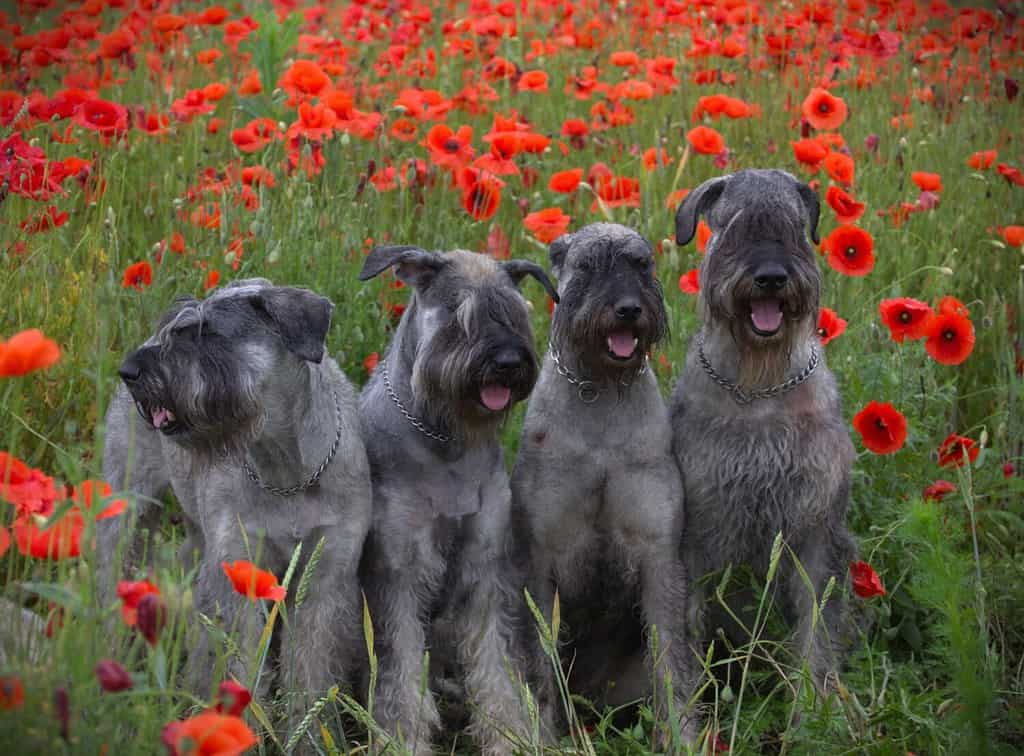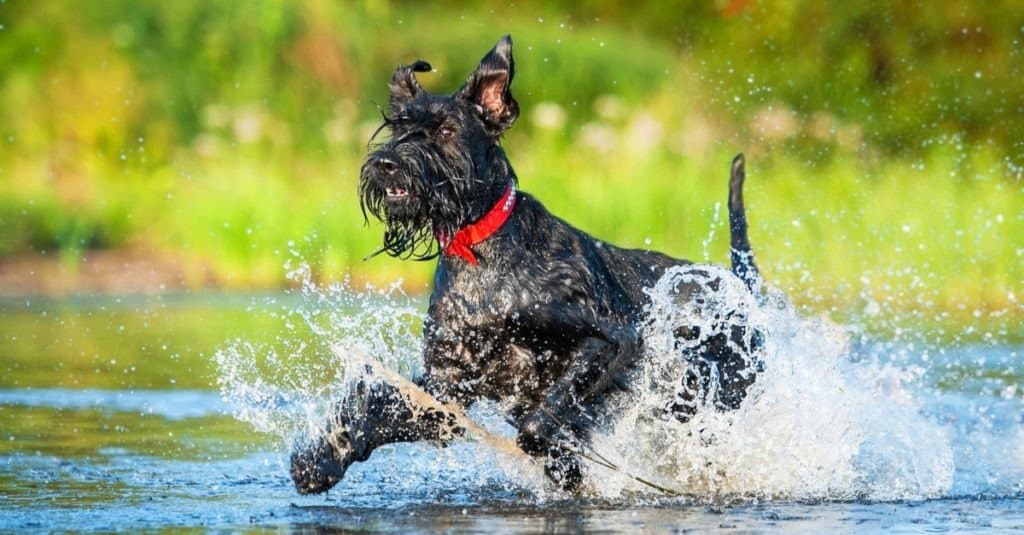Intelligent, loyal, and active, the Giant Schnauzer has been a beloved dog breed since the 1800s. If you own one of these dogs, you likely want to know what to expect as far as how long they live, as well as how to keep them happy and healthy for as long as possible. Below, we’ll take a look at the Giant Schnauzer’s typical life expectancy, common health issues, and what you should do to ensure they live a long, fulfilling life.
How Long Do Giant Schnauzers Live? Average Life Expectancy

Overall, the Giant Schnauzer is a healthy breed with a moderately long lifespan, particularly for a larger dog.
©Frank11/Shutterstock.com
The average life expectancy of a Giant Schnauzer is around 10 to 15 years, with the median maximum age being around 10 to 12 years.
Of course, this can vary significantly depending on your dog’s genetics, the quality of care you provide to them, and any health conditions or illnesses they have. The Giant Schnauzer breed is overall fairly healthy. However, they are prone to a handful of health conditions (which we’ll cover in more detail below).
It is certainly possible for Giant Schnauzers to live well beyond the median maximum age listed above. Notably, a Giant Schnauzer named Kaiser lived to be 14 years and 9 months old before eventually dying from cancer. His owners noted they purchased him from a reputable breeder to ensure healthy bloodlines and traits were passed on. Additionally, obedience training and an active, healthy lifestyle played a large role in the dog’s impressive lifespan.
What Health Issues Do Giant Schnauzers Experience?

Though they are fairly healthy overall, Giant Schnauzers are still prone to several health conditions.
©Vladimira Pufflerova/Shutterstock.com
Some of the most common health issues in Giant Schnauzers include:
- Hip dysplasia: A condition where the ball and socket of the hip grow at unequal rates while your dog is still a puppy, causing the joint to become deformed when your dog is an adult.
- Gastric dilatation and volvulus: Also known as bloat, this condition is common in large breeds with deep yet narrow chests. The stomach essentially twists in on itself and becomes full of gas. This can cut off blood supply to the stomach and quickly become fatal.
- Eye issues such as glaucoma, cataracts, and progressive retinal atrophy, which can affect your dog’s vision and even cause blindness.
- Skin infections or conditions like seasonal flank alopecia, which can cause your dog to lose patches of fur and skin hyperpigmentation, and allergies, particularly to certain dog shampoos. Proper grooming is essential to minimize these skin issues.
- Certain types of cancer, most commonly skin cancers like melanoma. Lymphoma and liver cancer are also common in this breed.
Overall, the most common causes of death in Giant Schnauzers are liver cancer and lymphoma, as well as heart issues like heart attacks and heart failure.
How to Keep Your Giant Schnauzer Healthy and Thriving

Giant Schnauzers are active dogs that enjoy plenty of exercise.
©Rita_Kochmarjova/Shutterstock.com
While Giant Schnauzers are healthy overall, it’s still essential to ensure your dog gets a proper diet, plenty of exercise, and regular vet visits to keep them thriving for the full extent of their lifespan. Let’s go over each of these factors in more detail below and why they’re so important.
Diet
In general, Giant Schnauzers do well on nutrient-dense, high-protein, limited fat diets. Your dog should get plenty of protein primarily from animal-based sources, including chicken, beef, lamb, turkey, eggs, and fish.
You should ideally feed your dog a balanced meal twice a day. Large-breed dog food formulas are best to support their metabolic and dietary needs. They should eat around 3 to 4 cups of a high-quality kibble or other type of dog food each day.
Keep in mind large dogs like the Giant Schnauzer also need more water than small breeds. As a general rule, your dog should drink around one ounce of clean, fresh water (around ⅛ of a cup) per pound of body weight every day.
Grooming
Proper grooming is a large part of your Giant Schnauzer’s health and keeping them feeling their best. This mainly involves brushing, bathing, and trimming the coat. The Giant Schnauzer is a trimmed breed with a breed-standard cut and a double coat: a wiry topcoat and a softer, more dense coat underneath.
You’ll need to take your dog to a groomer every month or so (or around every 4 to 6 weeks) for a thorough coat trim. Additionally, your dog should get a bath every two months or so, unless they’ve rolled in something or otherwise gotten their coat dirty in the meantime. Pay special attention to the fur around the face and along the legs. Their “beard” and legs should be washed separately every week or two.
In between full grooming sessions, it’s best to thoroughly brush your dog at least once or twice a week for 15 to 20 minutes at a time. Just like with bathing and trimming the coat, be especially mindful of your dog’s face and the fur along their legs.
Finally, make sure you clean your dog’s ears at least once a week with a vet-approved ear cleaning solution.
Exercise
Giant Schnauzers are highly active dogs that need plenty of exercise daily to be happy and healthy. Specifically, your dog should get at least 30 to 60 minutes of fairly vigorous exercise per day. This can be in the form of walks/runs, playtime, or even interactive games outside in your backyard or at the local dog park. These dogs love the outdoors, so outdoor play is ideal whenever possible.
Regular Vet Visits
While they are fairly healthy as a breed overall, your Giant Schnauzer should still see a reputable and experienced veterinarian at least once or twice per year. This is because they are prone to a wide range of health conditions. Fortunately, many of these conditions can be managed with medication and a proper diet. If your dog develops one of these health issues we covered earlier, you’ll want to get them diagnosed and treated as early as possible.
The photo featured at the top of this post is © iStock.com/Nemyrivskyi Viacheslav
Thank you for reading! Have some feedback for us? Contact the AZ Animals editorial team.






